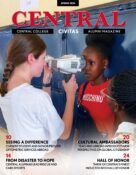When Jan Case ’76 sits down to create her artwork every day, she may end up with blood cells flowing through an artery or the delicate leaflets of the heart’s aortic valve. After earning her degree in art and art education from Central, Case has spent the past 23 years as a medical animator at Mayo Clinic in Rochester, Minn.
“From my point of view, so much of science is visual,” says Case, who creates animations of medical procedures for physicians at the clinic. “To really explain it to people you need the visual side. Looking at the human body and microscopic images is really beautiful.”
The Mayo Clinic has a reputation for excellence around the country, and patients come from hundreds of miles to be treated by doctors whose mantra is that patients come first. Case, along with three other animators and eight medical illustrators, supports a staff of 50,000 at the clinic.
Physicians use Case’s animations when they give talks around the country—and Mayo Clinic uses them to promote the cutting-edge research done on the premises. But one of the most common and important uses for Case’s work is patient education. If someone needs heart surgery, they first watch a DVD explaining the procedure. The surgeon’s sure movements, the heart’s even beat, the vessels severed and retied—all of it is animated by Case.
“A lot of the physicians have told us that our animations have really helped them explain things to their patients,” says Case. “They think it is really important to help people understand what is going on. I know it really helps the patients.”
http://www.youtube.com/watch?v=h1IklGV2CL4
Case says it’s been a pretty steep learning curve over the years, since she doesn’t have any formal medical training, but it has always been interesting. Nowadays, a new hire in the creative media services department would need a master’s degree in medical animation. But back in 1990, Mayo was looking for someone with solid art and design skills, and Case fit the bill. Her liberal arts background helped. And she fills in the rest as she goes.
Case meets with the surgeon or physician to learn the ins and outs of the procedure or research before she begins an animation. That means she is much more knowledgeable than the average person when it comes to the health sciences.
Recently, Case has been specializing in aortic aneurysms, a bulge in the walls of the aorta, the largest vessel in your body that carries blood directly from your heart to the rest of your body. If the walls burst due to high blood pressure, you can die in minutes. A few doctors at Mayo Clinic have developed a less invasive way of repairing these aneurysms—by threading a stent graft through the groin rather than an open incision in the abdomen. In order to gain FDA approval for the proc edure, they traveled around the country using Case’s animations as explanation.
Even though Case had never even heard of aortic aneurysms while at Central—or took many science classes—she still credits the college with her career in the health care industry. For one, her education classes were helpful. “A lot of my job is figuring out how to teach a person something,” she says.
Case also credits her excellent design and art skills to her alma mater, which took her somewhere she didn’t expect but is happy to be. “If it weren’t for Central, I wouldn’t be where I am today,” she says.














To encourage serious, intellectual discourse on Civitas, please include your first and last name when commenting. Anonymous comments will be removed.
Comments are closed.